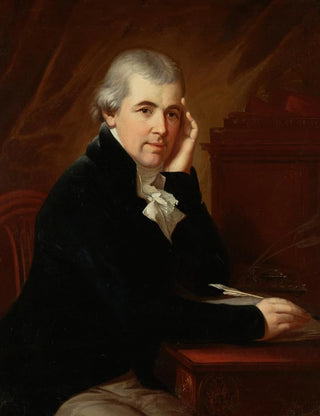Art print | Portrait of a Man - Johann Baptist von Lampi the Elder


View from behind

Frame (optional)
Portrait of a Man - Johann Baptist von Lampi the Elder – Captivating Introduction
In the vast panorama of art history, certain works stand out for their ability to capture the essence of an era, a personality, or a state of mind. The "Portrait of a Man" by Johann Baptist von Lampi the Elder fits into this tradition, offering a window into the 18th century, a pivotal moment in the evolution of European art. This piece, imbued with realism and psychological depth, not only reflects the talent of its creator but also the concerns and aspirations of a society in full transformation. Through this portrait, the viewer is invited to immerse themselves in an atmosphere where the past and present meet, revealing the richness of artistic heritage.
Style and uniqueness of the work
Johann Baptist von Lampi the Elder's style is characterized by an impressive mastery of pictorial techniques and meticulous attention to detail. In the "Portrait of a Man," each brushstroke seems charged with meaning, and every shadow and light is carefully studied to bring the figure to life. What immediately strikes is the way the artist manages to transcend mere physical representation to suggest genuine psychological depth. The subject's gaze, both penetrating and introspective, invites the viewer to question their thoughts and emotions. The color palette chosen by Lampi, subtle and harmonious, also contributes to creating a warm and welcoming atmosphere, making the portrait all the more captivating. In sum, this work stands out for its ability to combine impeccable technique with emotional expression.
The artist and his influence
Johann Baptist von Lampi the Elder, an artist of Austrian origin, managed to leave his mark on his era with a style that blends tradition and innovation. Trained in the workshops of great masters, he absorbed neoclassical influences while developing a personal and distinctive approach. His work is emblematic of a period when the portrait became a means of asserting social status and personality. Lampi was able to capture the spirit of his time, painting not only members of the aristocracy but also intellectual and artistic figures.

Matte finish

View from behind

Frame (optional)
Portrait of a Man - Johann Baptist von Lampi the Elder – Captivating Introduction
In the vast panorama of art history, certain works stand out for their ability to capture the essence of an era, a personality, or a state of mind. The "Portrait of a Man" by Johann Baptist von Lampi the Elder fits into this tradition, offering a window into the 18th century, a pivotal moment in the evolution of European art. This piece, imbued with realism and psychological depth, not only reflects the talent of its creator but also the concerns and aspirations of a society in full transformation. Through this portrait, the viewer is invited to immerse themselves in an atmosphere where the past and present meet, revealing the richness of artistic heritage.
Style and uniqueness of the work
Johann Baptist von Lampi the Elder's style is characterized by an impressive mastery of pictorial techniques and meticulous attention to detail. In the "Portrait of a Man," each brushstroke seems charged with meaning, and every shadow and light is carefully studied to bring the figure to life. What immediately strikes is the way the artist manages to transcend mere physical representation to suggest genuine psychological depth. The subject's gaze, both penetrating and introspective, invites the viewer to question their thoughts and emotions. The color palette chosen by Lampi, subtle and harmonious, also contributes to creating a warm and welcoming atmosphere, making the portrait all the more captivating. In sum, this work stands out for its ability to combine impeccable technique with emotional expression.
The artist and his influence
Johann Baptist von Lampi the Elder, an artist of Austrian origin, managed to leave his mark on his era with a style that blends tradition and innovation. Trained in the workshops of great masters, he absorbed neoclassical influences while developing a personal and distinctive approach. His work is emblematic of a period when the portrait became a means of asserting social status and personality. Lampi was able to capture the spirit of his time, painting not only members of the aristocracy but also intellectual and artistic figures.






